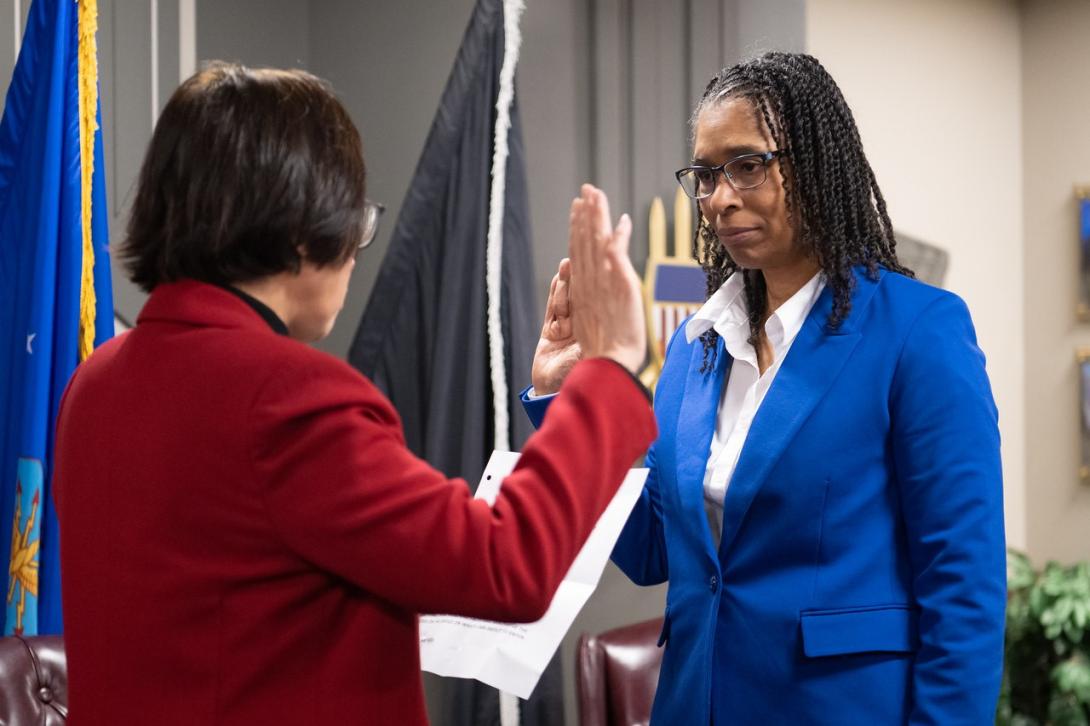Meet the Pentagon’s First-Ever Assistant Secretary of Defense for Science and Technology
Just months into her new role, Aprille Ericsson, the U.S. Defense Department’s first assistant secretary of defense for science and technology, or ASD (S&T), is taking steps to enhance cooperation and information sharing within the department, across government, among closely allied nations and with academia.
Ericsson took the oath of office in late March, and by early October, had already met with counterparts in other countries, supported a rebranding of a major international science and technology cooperation program and initiated the building of a new collaboration hub based on the Defense Advanced Research Projects Agency’s (DARPA’s) DARPAConnect hub.
DARPAConnect launched in 2022 with a goal to “broaden DARPA’s reach and stimulate growth and collaboration with small businesses and education institutions new to the national security space,” according to the DARPAConnect website. With a focus on underrepresented, diverse and nontraditional performers, DARPAConnect aims to break down barriers of entry to find groundbreaking solutions. The effort is built on a partnership intermediary agreement with the Applied Research Institute, which facilitates pop-up events in a few cities around the country along with education opportunities, workshops, a mentor/ambassador component and other outreach efforts.
Ericsson initially indicated the new hub already has been branded but that she didn’t want to “let the cat out of the bag” too soon. But a follow-up email exchange with a Pentagon spokesperson revealed the name will be DoD SciTechConnect.
It will essentially be DARPAConnect+.
“DARPAConnect is just the beginning of the model. It actually adds a bunch of other pieces that aren’t under the DARPAConnect model. That would give you a strong idea of what our future connect hub will look like. That’s just the beginning, though,” Ericsson reported.
Among other information, the future hub will include:
- science, technology, engineering and mathematics programs, commonly known as STEM, scholarships
- business opportunities
- training seminars
- one-on-one proposal guidance
- activities calendar
- Federally Funded Research and Development Center capabilities
- Small Business Innovation Research and Small Business Technology Transfer programs
Ericsson said the hub will help the small business programs “by helping partners who typically have not really had to go through the rigor but allow us to get proposals that are better and more solid,” so that “we’re not wasting time on reviewing proposals that really won’t have a chance of winning,” while also giving those small businesses the “confidence that they need to be successful in doing work with us in the future.”
The future hub will likely also include information from and for the military services, National Science Foundation and NASA while providing resources for historically black colleges and universities and minority partners.
Additionally, international allies and partners may be able to use the hub. “What I really want us to see is more usage with the people that are here in the Department of Defense, but also potentially with our international partners in a safe, protective environment,” she offered.
The hub will allow officials to assess investments. “We would like to have it so that it is a searchable archive that really allows us to not just archive the information but be able to assess it and determine the different activities, the different investments we made and really look at our return on investment,” the ASD (S&T) explained.
Furthermore, it will allow officials to keep track of the multitude of military S&T programs. “There’s so many different projects that are going on across the Department of Defense and across the services. How does one access all of that information? Is it in a repository that is accessible? I mean, information and knowledge is power, and I think that is a really important capability that we continue to mature and grow,” Ericsson said.
As of October, the Department of Defense (DoD) was engaging two potential vendors, and Ericsson suggested the new hub might launch before the New Year.
Her collaboration efforts extend beyond America’s borders. In her first several months in the position, Ericsson visited her counterparts from Australia, Canada, New Zealand and the United Kingdom under a technology cooperation agreement formerly known as the Technical Cooperation Program, or TTCP. Along with the United States, the group of nations is known as the Five Eyes countries because they partner closely on intelligence-related security matters.
In fact, in a late September meeting in Australia, the group voted to change the name from TTCP to Five Eyes S&T, even though they continue to meet under the TTCP memorandum of understanding. Ericsson reported that the renaming was needed because the program had unfairly garnered a less-than-stellar reputation. “I understand that TTCP unfortunately had a not nice brand for it. The acronym people would jokingly say was the ‘traveling cocktail party.’ What would occur there is that every year they travel to a different partner [nation]. Their space and time is utilized by that host nation, and of course, [the host nation is] going to pull out all the stops and treat you very well while you’re in their country,” she said. “But we do get an opportunity to have a peek under the hood, and these meetings were really very productive. They were an opportunity to see where you could partner together or work together or do testing together. What was felt, though, was that it created a negative slant on the institutions.”
At that meeting, the five nations also assessed where they might be able to cooperate on technologies in earlier stages of development, or lower technology readiness levels (TRLs). “We really looked at how we provide that sort of infusion of knowledge at earlier technology development levels. And I use TRLs to explain where we look at the sweet spot of, say, prototypes prior to manufacturing, but also guiding where we would want to be able to partner with them on credible opportunities, things like AUKUS and Stocktake.”
AUKUS refers to a 2021 trilateral security partnership among Australia, the United Kingdom and the United States. It is designed to enhance information and technology sharing and support greater integration of security and defense-related science, technology, industrial bases and supply chains.

I came in with the understanding that the portfolio actually tapped into a lot of my strengths.
Stocktake is a bilateral cooperative effort between the United States and the United Kingdom. In addition to Australia, the ASD (S&T) also has visited the United Kingdom to discuss technology sharing possibilities.
“We had really great discussions with the various communities of interest under those teams, guiding and looking at strategy for the future. But also looking at the successes and how we get them to the next step. Meaning that technology transitions to a point where either our military service labs can take it on, so that the military services can end up eventually purchasing it. That would be some of the goals internationally.”
Ericsson indicated the Defense Department culture is more siloed than the one she experienced at NASA, where she spent the majority of her accomplished career. “Internally, I’ve been trying to break down barriers and silos. I say silos because the way that people work here is they really focus on being productive in their own realm and their own portfolios. But for me as an attitude control systems engineer, that word ‘systems’ really means that you’re pulling multiple aspects of something together. When you’re talking about being innovative, you need to have this dialog to create synergistic moments between the different disciplines.”
So far, she has found the Defense Department “has many aspects that either hinder or help my ability to succeed,” but indicated she hopes for a mutually beneficial working relationship with the Office of the Director of Operational Test and Evaluation, the CIO organization and others.
Last year, the Pentagon established Ericsson’s position and two other assistant secretary of defense posts reporting to Undersecretary of Defense for Research and Engineering Heidi Shyu. The other two are assistant secretary of defense for critical technologies and assistant secretary of defense for mission capabilities. On February 28, Ericsson became the first to receive Senate confirmation.
In this position, she directs the organization responsible for the oversight of and advocacy for the department’s S&T enterprise, including workforce and laboratory infrastructure policy, Federally Funded Research and Development Centers and University-Affiliated Research Centers.
According to her bio, she oversees a broad portfolio of S&T programs, including basic research, Small Business Innovation Research/Small Business Technology Transfer and DoD Manufacturing Technology, including the nine Manufacturing Innovation Institutes. She also is responsible for focused outreach and interaction with historically Black colleges and universities and minority institutions, which encourage diversity, equity, inclusion, and accessibility, and kindergarten-12th grade (K-12) programs. Furthermore, she is responsible for the department’s technology and program protection initiatives.
She said she was pleased with how well the role fits her more than 30 years of experience at NASA. “I came in with the understanding that the portfolio actually tapped into a lot of my strengths. It was created prior, so I was pleasantly surprised, like, oh, I can check off a lot of experiences here to support this office.”





Comments